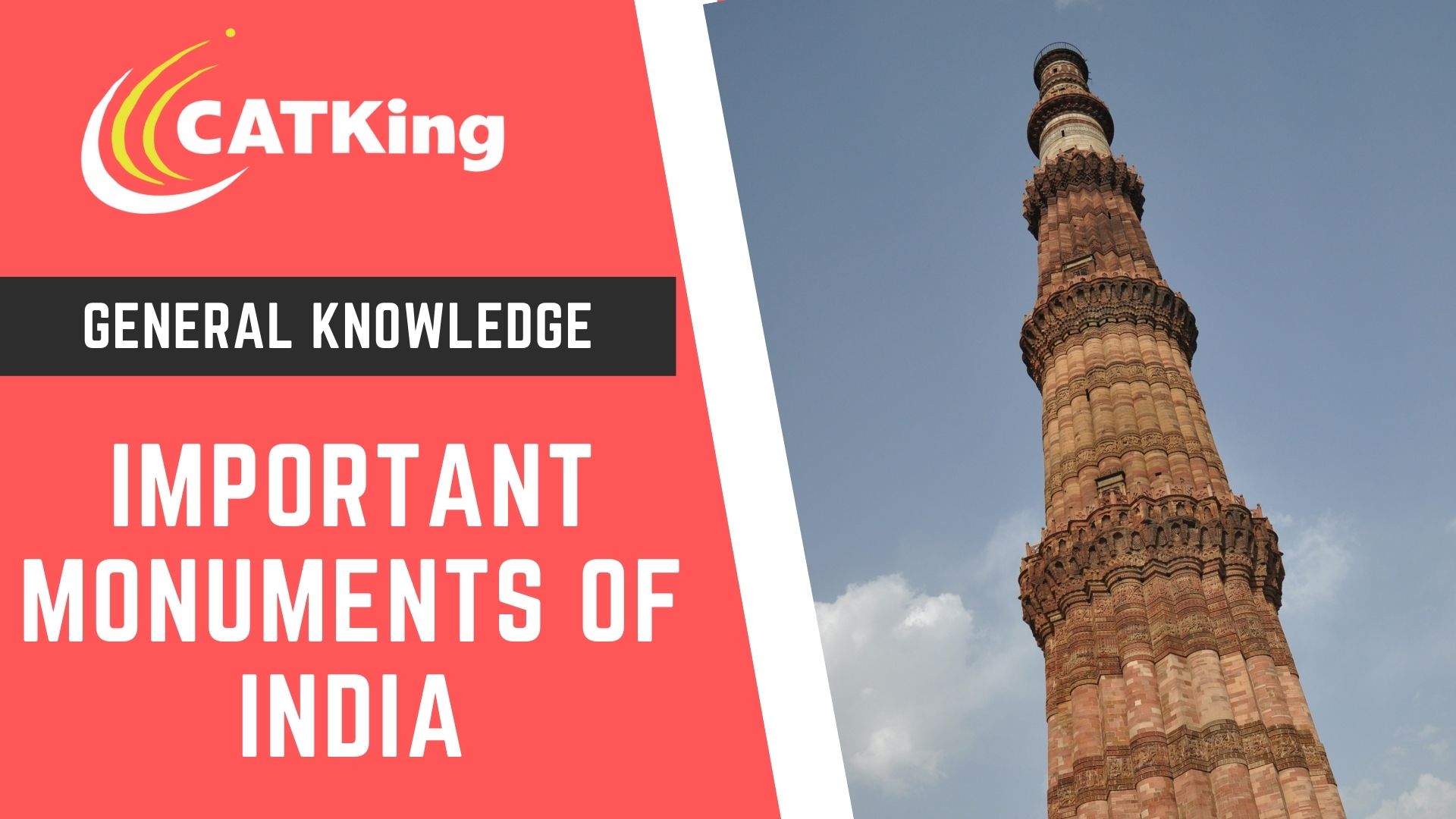List of Important Monuments of India
List of Important Monuments of India:
India’s Monuments show a great deal of cultural heritage and the deep historical glory of our country. Exam point of view, questions on Monuments of India can be expected in the Static Gk section of MBA exams like IIFT, XAT, CMAT, etc.


What is a Monument?
A monument is a type of structure that was explicitly created to commemorate a person or event, or which has become relevant to a social group as a part of their remembrance of historic times or cultural heritage, due to its artistic, historical, political, technical, or architectural importance.
State-wise list of Monuments:
1) Maharashtra
A) Gateway of India
Location: Mumbai, Maharashtra
Architect: George Wittet
Architecture style: Indo-Saracenic with Muslim influences
Year of construction: 1913
The Gateway of India is a monument that was built to commemorate the landing of King-Emperor George V and Queen-Empress Mary, the first British monarch to visit India. The monument stands guard facing the Arabian Sea.
B) Ajanta-Ellora Caves
Location: Aurangabad, Maharashtra
Built By: Gupta Dynasty
Year of construction: 1983
The Ajanta and Ellora caves are UNESCO-registered World Heritage Sites. The murals in these caves depict stories from the Jatakas. Later caves reflect the artistic influence of the Gupta period, but there are differing opinions on which century in which the early caves were built.
C) Bibi Ka Maqbara
Location: Aurangabad, Maharashtra
Built By: Aurangazeb
Architect: Ata-ullah, Hanspat Rai
Architecture style: Mughal Architecture
Year of construction: 1660
The Bibi Ka Maqbara was built by Mughal Emporer Aurangazeb in the memory of his beloved wife Dilras Banu Begum. The monument is also called Dakkhani Taj due to its striking resemblance to the Taj Mahal.
D) Shanivar Wada
Location: Pune, Maharashtra
Built By: Peshwa Baji Rao I
Architecture style:Maratha Imperial Architecture
Year of construction: 1732
The Shaniwar Wada was the royal abode of the Peshwas. The fort shows the glorious culture and pride of the Maratha Dynasty.
Also read: How to prepare G.K for MBA Exams
2) Delhi
A) Qutub Minar
Location: Old Delhi, Delhi
Built By: Qutb ud-Din Aibak
Architecture style: Indo-Islamic architecture
Year of construction: 1192
The Qutub Minar was built as victory tower/ as a minaret to the muezzins. It is one of the highest minarets in India with a height of 73 meters. Built-in red sandstone consists of five storeys and a spiral staircase with 379 steps is a real masterpiece of Mughal Islamic craftsmanship.
B) Red Fort
Location: New Delhi, Delhi
Built By: Emporer Shah Jahan
Architect: Ustad Ahmad Lahori
Architecture style: Mughal Architecture
Year of construction: 1638
The Red Fort is also known as the Lal Quila because it is made up of red sandstone. Mughal Emporer Shah Jahan but the fortress when he decided to shift his capital from Agra to Delhi. Today the Red Fort is used as an army cantonment. Every year on India’s Independence Day (15 August), the prime minister of India hoists the national flag at the Red Fort and delivers a nationally broadcast speech from its ramparts.
3) Rajasthan
A) Hawa Mahal
Location: Jaipur, Rajasthan
Built By: Maharaja Sawai Pratap Singh
Architect: Lal Chand Ustad
Architecture style: Blend of Hindu Rajput architecture and the Islamic Mughal architecture
Year of construction: 1799
The Hawa Mahal is a monument built for royal women to enjoy the events and festivals in the street. The Hawa Mahal means “Palace Of Winds”. The structure built in red and pink sandstone consists of about 953 windows. These windows are known as “Jharokhas”. decorated with intricate latticework.
B) Dilwara’s Jain Temple
Location: Mount Abu, Rajasthan
Architect: Vimal Shah, Vastupala-Tejpal
Architecture style: Jain Temple Architecture
Year of construction: 1031 AD
The Dilwara’s Temples are famous for their use of white marble and intricate marble carvings. The Dilwara temples are named after the ministers of the then Vaghela ruler of Gujarat who built them in 1230 A.D.
4) Uttar Pradesh
A) Taj Mahal
Location: Agra, Uttar Pradesh
Built By: Emporer Shah Jahan
Architect: Ustad Ahmed Lahori
Architecture style: Mughal Architecture
Year of construction: Between 1632 and 1653 AD
The majestic Taj Mahal was built as a memorial to Shah Jahan’s beloved wife Mumtaz Mahal after her death in 1631. The materials the monuments used are white marble for the main mausoleum and red sandstone for fortifying structure and accents. The Taj Mahal is one of the Seven Wonders of the World. The structure houses the tomb of both Mumtaz Mahal as well as Shah Jahan.
B) Fatehpur Sikri
Location: Agra, Uttar Pradesh
Built By: Emporer Akbar
Architecture style: Indo-Islamic, Mughal Architecture
Year of construction: 1986
The red sandstone built monument was built to honor the Sufi saint Salim Chishti and the entire palace complex is built around the Sufi saint’s tomb. Buland Darwaza gate is the entrance to the Jama Masjid mosque.
5) West Bengal
A) Victoria Memorial
Location: Kolkata, West Bengal
Architect: Conceptualised by George Curzon, Viceroy of India
Architecture style: Indo-Saracenic revivalist style
Year of construction: Between 1906 to 1921
The Victoria Memorial was built to commemorate the death of Queen Victoria, in 1921. This huge white-marble museum, made from Makrana marble from Rajasthan, is filled with a vast collection of remnants from the period of British Empire rule in India.
6) Orissa
A) Sun Temple
Location: Konark, Orrisa
Built By: Kalinga Dynasty
Architecture style: Kalinga architecture
Year of construction: 13th-century CE
The temple is attributed to king Narasimhadeva I of the Eastern Ganga Dynasty. Sailors used to refer to the Sun Temple of Konarak as the Black Pagoda because it was supposed to draw ships into the shore and cause shipwrecks. The wheels of the temple are sundials, which can be used to calculate time accurately to a minute.
B) Jagannath Temple
Location: Puri, Orissa
Built By: Anantavarman Chodaganga
Architecture style: Kalinga Architecture
Year of construction: 12th century CE
The Puri temple is one of the greatest monuments of India and is famous for its annual Ratha Yatra, or chariot festival, in which the three principal deities are accompanied by the devotees into a procession on huge and elaborately decorated temple cars.
7) Madhya Pradesh
A) Sanchi Stupa
Location: Sanchi, Madhya Pradesh
Built By: Emporer Ashoka
Architecture style: Buddhist Art and Architecture
Year of construction: 3rd century BCE
The Stupas of Sanchi were constructed on the orders of Emperor Ashoka to preserve and spread Buddhist philosophy. The hemispherical structures of Sanchi Stupa made out of locally quarried sandstone, house the relics of Buddha and his followers.
8) Telangana
A) Char Minar
Location: Hyderabad, Telangana
Built By: Qutub Shahi Dynasty
Architect: Muhammed Quli Qutb Shah
Architecture style: Islamic Architecture
Year of construction: 1591 CE
Char Minar was built to commemorate the end of the plague. The Charminar was the first monument in the world constructed using lime mortar and granite. The Charminar’s long history includes the existence of a mosque on its top floor for more than 400 years.
















Leave a Reply
You must be logged in to post a comment.